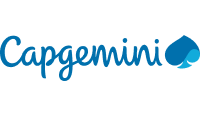About Capgemini
Capgemini partners with companies to transform and manage their business by unlocking the value of technology. They are currently the global leader in consulting, technology services, and digital transformation.
Nowadays, Capgemini has been open for over 50 years, operates in 50+ countries worldwide, and employs more than 340,000 people.
Manual processes and paperwork with room For improvement
Although Capgemini works to expand the tech stacks available for their clients, their internal HR team within the Bsv operation (Business Service V) realized how unsatisfied their employees were with the services provided to them.
In 2017, Capgemini’s Brazil HR department was responsible for receiving and resolving employee requests, such as bank account changes or benefits management. After measuring their process efficiencies (or lack thereof), they quickly realized how much more could be done.
One of their goals was to triage 95% of tickets within the correct SLA. They hadn’t achieved this goal for nine months in a row and only reached a success average of 38%.
The HR team received an average of 2,500 requests per month through many channels, like email, direct messages, and verbally, without any categorization or prioritization. They allocated 5 full time employees to manually triage and process their requests.
This legacy process also had pre-existing bottlenecks that negatively affected their employee’s experiences. Requesters were required to print a document, collect their manager’s signature, and scan it just to submit a request. This experience was frustrating and highly inefficient.
After analyzing this process, Capgemini’s HR leaders identified several opportunities to improve the process. The main objectives became meeting defined SLAs and improving the experience of all stakeholders.
The beginning of an efficient journey
The first step to achieve better results is identifying the problems and bottlenecks of processes. For Capgemini’s HR team, leaders, and requesters, the main painpoint was lacking a standardized platform to receive and treat requests. Also, the high volume of manual work was a problem for all stakeholders expanding far beyond SLAs because of time-consuming repetitive tasks.
After realizing the main bottlenecks and pains of their employees, Capgemini’s HR department started the second step of the project: mapping the 95 types of requests, like medical leave, benefits management, recruitment, training, and offboarding. They aimed to standardize all processes, from request opening to delivery (before even thinking about implementing automation).
Some months after the project started, the HR team created a “Talk to HR” initiative, which includes a single portal for opening requests and sending automatic updates to all employees.
The portal is in its 2.0 version, combining multiple platforms:
- Pipefy for workflow standardization and automation
- RPA (UiPath) for scripting repetitive tasks, like requests triage and updates to all employees
- Chatbot to answer the most common questions and send clear directions to internal clients
- Sharepoint to complete the single sign-on process, ensuring only Capgemini employees can access the portal
Pipefy was implemented for this project in 2017 and continues to provide improved process orchestration across all HR processes.
Efficient processes, better SLAs, and real benefits
Less than one year after implementing Pipefy, Capgemini’s HR team has already achieved great results with their “Talk to HR” portal. The benefits have impacted the three main stakeholders of this process: HR team, managers, and requesters (internal clients).
For the HR team, who receive and deliver all HR requests, Pipefy allows them to centralize all requests in a single portal and move from manual work to now focus on value-added activities and more complex requests.
For HR managers, Pipefy has increased the results of the team. Before Pipefy, these HR requests used to take 5 full time employees’ time. Nowadays, only 1.5 full time employees are required. Also, the ability to measure each step of the process allows managers to continuously improve the workflows to achieve even better results.
For HR requesters, the most important stakeholder of this project, Pipefy brought higher customer satisfaction by offering a single portal to open any request. This allowed for faster deliveries, and the SLA moved from 38% achievement to a monthly average of 98% achievement.
All these great results also came with a financial benefit. Even after increasing the number of monthly requests, which is now around 2,800, the HR team reduced the costs of managing HR Requests by 42%, achieving a positive ROI within months. This quick result empowers Capgemini to keep searching for new opportunities to use Pipefy and achieve even greater results.
Transform your HR process
with Pipefy

